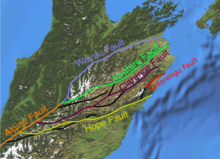Hope Fault
The Hope Fault is a roughly 230 km long geological fault in the Canterbury region on the South Island of New Zealand . It is an active part of the Marlborough Fault Zone ( MFZ ) and was significantly involved in the Kaikoura earthquake with a magnitude of 7.8 M W on November 14, 2016.
geography
The Hope Fault runs on the southwestern edge of the Marlborough Fault Zone in an east-west direction and extends over 230 km, starting from the Alpine Fault in the west to the east coast of the South Island north of Kaikoura . To the north of the faults, the Seaward Kaikoura Range runs parallel.
The Hope Fault is divided into different segments from a geological point of view, from west to east into the Harper Pass segment , the Hope River segment , the Conway segment , the Kahutara segment , the Mount Fyffe segment and the Seaward segment . The speed with which the two sides of the fault move against each other within the various segments is given as between 15 and 42 mm per year. The Hope Fault thus has the highest displacement rate in the Marlborough Fault Zone .
The Hope River segment lies west of the Conway segment and got its name from the fact that the Hope River runs directly over the part of the fault .
The Conway segment has a length of around 70 km and lies between the Kowai River and the Hanmer Basin . In contrast to the other segments, it is relatively linear and has a displacement rate of 18 to 22 mm per year. The segment is believed to have been involved in two quakes in 1768 and the 1830s.
Historical earthquakes
According to earthquake expert Holden of GNS Science, the last earthquake known before 2016, in which the Hope Fault was significantly involved, occurred in the Hope River segment in 1888 (see North Canterbury earthquake of 1888 ). It is to a thickness of between 7.0 and 7.3 M W have exhibited and sometimes produces a horizontal displacement of approximately 2.50 m. Based on this event, the expert carried out his investigations and mentioned in his publication in 2014 that due to the tectonic movements - the southeastern part of the South Island of New Zealand moves in a southwestern direction at 36 mm per year - the Hope Fault again has a potential of strength 7 M W plus, an assumption that was confirmed by the Kaikoura earthquake on November 14, 2016.
See also
literature
- Robert Langridge, Jocelyn Campbell, Nigel Hill, Verne Pere, James Pope, Jarg Pettinga, Beatriz Estrada, Kelvin Berryman : Paleoseismology and slip rate of the Conway Segment of the Hope Fault at Greenburn Stream, South Island, New Zealand . In: Geoscience Society of New Zealand (Ed.): Annals of Geophysics . Vol. 46 N. 5 . Wellington October 2003, p. 1119–1139 (English).
- C. Holden : Ground motion modeling of an Alpine fault earthquake and a Hope fault earthquake for main South Island cities (NZ) . In: GNS Science (Ed.): GNS Science Consultancy Report . 2014/257 . Lower Hutt November 2014 ( online PDF 2.6 MB [accessed January 22, 2017]).
Individual evidence
- ↑ a b Langridge, Campbell, Hill, Pere, Pope, Pettinga, Estrada, Berryman : Paleoseismology and slip rate of the Conway segment of the Hope Fault ... . 2003, p. 1119 (English).
- ↑ Brendan Duffy, Betsie Hoppera : New Lidar data reveals slip transfer from 6 the Hope Fault to the Kaikoura Fault . Ed .: Department of Geology, University of Canterbury . Christchurch 2015 ( online PDF 1.2 MB [accessed January 22, 2017]).
- ↑ Langridge, Campbell, Hill, Pere, Pope, Pettinga, Estrada, Berryman : Paleoseismology and slip rate of the Conway segment of the Hope Fault ... . 2003, p. 1121 (English).
- ↑ Holden : GNS Science Consultancy Report 2014/257 . 2014, p. 12 .
- ↑ Holden : GNS Science Consultancy Report 2014/257 . 2014, p. 4 .
- ↑ Holden : GNS Science Consultancy Report 2014/257 . 2014, p. iv .

